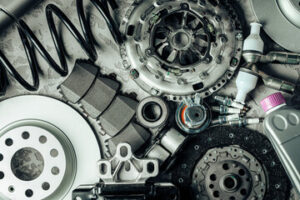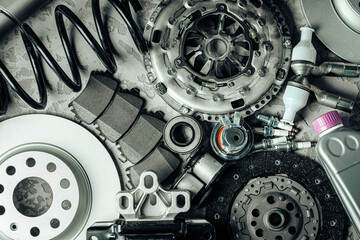Trucks are a vital part of the economy, and they need to be well maintained to keep the states going. 
If you’re thinking about becoming an owner-operator, be sure to get solid business advice from accounting and legal professionals. It’s a big step!
Brakes are one of the most important truck parts, as they help keep trucks safe on the road. However, they do need regular maintenance and care to ensure they continue to work properly. This is especially true when they are used in high-performance vehicles, which require a lot of power to slow down and stop. This is why many truck owners choose to upgrade their brakes with high-quality aftermarket parts.
Brake system components include brake fluid, calipers, brake pads, and rotors. The brake pedal is also included, which is activated by a driver by pushing down on it. Depending on the type of truck, some may have drum or disc brakes. The main function of any brake is to convert the kinetic energy of the truck into heat energy, which brings it to a stop within a short distance.
When selecting brake pads, a driver should consider the vehicle’s driving style and the number of stops made each day. For example, a driver who often speeds up and down hills will need harder brakes to cope with the increased demands on the braking system. Likewise, driving in heavy traffic or making frequent stops will cause the brakes to generate more heat, which can reduce their effectiveness and lead to premature wear.
The rotors and calipers of the brake system are another factor that can influence how quickly the brakes will wear out. For instance, a warped rotor or stuck brake caliper can increase the amount of friction between the brake pad and rotor, which can cause them to wear out more quickly.
A brake fluid reservoir is another key component of the braking system, as it stores the hydraulic pressure that’s transferred to the brake assembly. The reservoir is usually found underneath the vehicle’s floor, along with the master cylinder, which houses the push rod that activates the brakes.
Finally, the brake lines and hoses carry the brake fluid from the master cylinder to the brake assemblies. These hoses can become damaged, causing leaks and other problems. If the brake hoses are damaged, they will need to be replaced, as will the brake fluid itself.
Tires
The tires are one of the most important truck parts because they help transfer traction and braking forces to the road surface and also absorb road shocks. In addition, they allow the vehicle to change direction and maintain speed. The tire tread has a significant impact on the driving performance of your truck, and it is recommended to choose a thicker tread for off-road conditions.
The main components of the tire are rubber, steel wires, carbon black, and other reinforcing materials. Natural rubber is a key raw material, and it is extracted from the rubber tree, which is grown in the tropics. In addition to this, synthetic and oil-based rubbers are used in the production of tires.
Tire size has a huge impact on the handling and traction of a truck, as well as its acceleration, stopping power, and fuel efficiency. The biggest tires are best for off-road conditions and can handle rough, muddy terrain easily. On the other hand, smaller tires are better for highway speeds and can reduce the overall weight of the truck.
Trucking companies need to make sure their trucks have the right tire size to ensure safe and reliable operation. It’s also essential to make sure the tires are properly inflated and maintained for maximum fuel efficiency.
In addition to maintaining proper air pressure, it’s vital to inspect the tires for signs of wear and damage. Regular inspections will prevent flat tires, which could cause delays that hurt business. It’s also important to have a spare tire in case of an emergency.
When choosing a new set of tires for your truck, you should consider the backspacing and offset. These are measurements that indicate how far the wheel is from the axle. The bigger the backspacing, the closer the wheel is to the suspension and other truck parts.
When it comes to replacing your truck’s tires, you should always check the owner’s manual to see what the manufacturer recommends for your model. If you’re looking to put larger tires on your truck, you may need a lift kit or new rims to accommodate them. It’s also important to know how much the larger tires will affect your mileage and if you can get them to fit the existing lugs.
Transmission
The transmission is the component that allows power to be sent from a power source, usually an engine, to a drive mechanism. It does this by using gears and clutches to convert speed into torque. It can be either automatic or manual. Manual ones require the driver to decouple the transmission with a clutch pedal in order to shift gears up or down manually. Automatic transmissions, on the other hand, do this automatically for you.
As with any mechanical component in a truck, it’s important to keep it well maintained and serviced. A poorly functioning transmission can put your truck in a lot of danger, especially when you’re hauling heavy loads or going through tough terrain. The good news is that many truck parts are relatively inexpensive to replace and can help you save a lot of money on expensive repairs down the road.
There are a few key things you can do to keep your transmission performing at its best. The first is to always use quality OE (original equipment manufacturer) replacement parts. OE parts are designed to match the original part that came with your truck, so they’ll fit perfectly and provide the best performance. The second is to check the fluid levels regularly and change them when needed. Lastly, be sure to use the right type of transmission fluid. You’ll find a variety of different transmission fluid types, and you should read the label on the bottle to make sure you’re getting the right one for your particular vehicle.
Pickup trucks and large SUVs are typically much heavier than smaller cars, so they put more stress on their transmission systems and other components. Steep grades, stop-and-go traffic, faster acceleration capabilities, and other factors can all put extra strain on a truck’s transmission system, which can cause it to experience internal damage or even fail altogether.
While today’s modern transmissions are engineered to handle the extra strain and power, they can still be prone to problems if not driven properly. A simple thing like low transmission fluid can lead to all sorts of issues down the line, so make sure to check the level frequently and change it when needed.
Engine
The engine in a truck is what generates power to drive the vehicle. It consists of several components, including pistons, a cylinder block and head, and a crankshaft and valve train. The parts used in larger truck engines must be able to withstand greater temperatures than those found in non-commercial vehicles, and they are usually made of higher-quality materials.
Because a truck’s engine is so important to the vehicle, it requires a great deal of maintenance to keep it running well. One of the most common maintenance tasks is replacing the engine oil. This prevents the motor from overheating and can extend its life. Another essential service is adjusting the air and fuel filters to ensure the engine is receiving clean, fresh air and a proper fuel mixture.
Besides performing standard maintenance, truck owners can use aftermarket parts to upgrade the performance of their trucks. For example, an upgraded exhaust system can increase horsepower and torque, while a cold air intake can help improve fuel efficiency and power output. Aftermarket suspension components, such as performance shocks and airbags, can also improve ride quality, handling, and towing capacity. Other popular truck performance upgrades include tuners or programmers that optimize the engine’s ignition timing and fuel mixture to deliver more power and fuel efficiency.
While heavy-duty truck parts are designed to withstand the roughest of conditions, it’s still possible for them to require replacement. For that reason, it’s a good idea to have truck spare parts on hand so you can quickly repair or replace them when needed.
